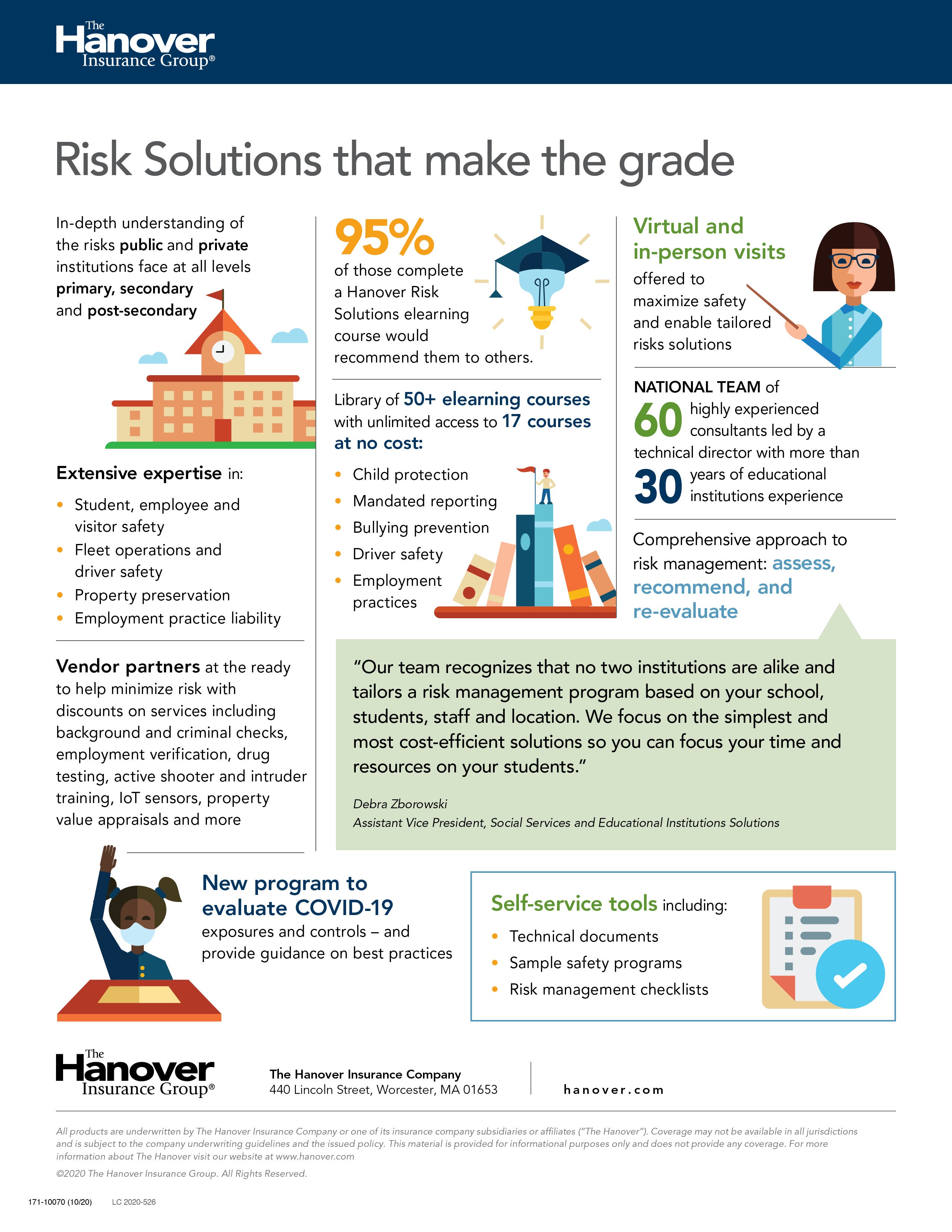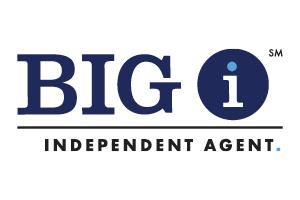As seen in Independent Agent
The Hanover is committed to helping independent agents better source and serve small business customers.
The small business insurance market has been evolving at a rapid pace. Enhanced technology, better access to data, and changes in consumer behavior have created opportunities for businesses, but also brought inherent risk. The impact of the COVID-19 pandemic further illustrates the need for proper insurance coverage, risk management practices and experienced counsel.
As a company committed to the success of its independent agent partners, The Hanover is well positioned to respond to these market dynamics. Through multi-million-dollar investments in technology combined with value-added products and services, the company is focused on creating a better insurance experience for agents and small business customers
Independent Agent recently spoke with the small commercial insurance experts at The Hanover, along with one of its leading agent partners, to learn more about the company’s plans, as well as its perspective regarding emerging risks to small businesses, the role of digital enhancements and technology across the insurance landscape, and the unique ways agents can expand their small business customer base.
INDEPENDENT AGENT: As you think about the experience of small business owners over the last year, what is The Hanover seeing and what should small businesses anticipate in the future?
MICHAEL R. KEANE, President of Core Commercial at The Hanover: Thinking back to pre-COVID-19, the industry was already feeling pressures, with insurance carriers taking rate in commercial auto and general liability. This has driven small businesses to think more critically about their insurance. In fact, research from The Hanover found that after a rate change, 75% of business owners reviewed and evaluated their policies and coverages.
The Hanover’s consultative approach— where we get to know clients’ businesses and using our deep industry expertise with risk insights — is more important than ever. Our insurance products and underwriting will need to adapt to evolving exposures, especially considering evolving litigation trends.
As many businesses start to reopen, we are thinking about the impact of a declining economy and changes in norms to our customers and their exposures.
Layoffs, furloughs, part-time work and hiring/rehiring practices present concerns for companies. This may include challenges with discrimination lawsuits and more. Reduced sales, economics changes and evolving exposures including a movement to online sales also require careful consideration.
Add to that the COVID-19-related societal changes we’ve experienced, like working from home. It remains to be seen what will be temporary and what will be permanent. We don’t know to what extent companies might reduce office workspaces, move to online sales or increase remote working. This could lead to a more permanent reduction in miles driven, an increase in business property in employees' homes, and the closing of physical storefronts and offices. These things may mean a shift in exposures. For example, cyber exposures can increase as controls are weakened by remote work. General liability and workers’ compensation risks may look different. With all that is happening, The Hanover is increasingly focused on being collaborative, agile and responsive, ultimately creating a better insurance experience.
INDEPENDENT AGENT: What are some emerging exposures in small commercial?
CHARLES F. HAMANN, Deputy President of Small Commercial at The Hanover: Earlier this year we published our annual Small Business Risk Report in collaboration with Forbes Insights. We learned that business owners feel more vulnerable than previous years to allegations of workplace discrimination, wrongful termination and harassment. This demonstrates the need for broad employment practices liability (EPL) coverage, which many small businesses may not automatically purchase or may purchase with minimal limits.
Similarly, providing any level of consulting or professional services can lead to an errors and omissions exposure (E&O) that may not be covered under some standard policies. Our research shows 41% of small business owners provide advice, consultation or training, illustrating the need for E&O protection. For example, real estate agents, home inspectors, event planners and advert sing agencies may benefit from E&O coverage.
INDEPENDENT AGENT: What does the company see as the most sought-after coverage for small businesses?
KEANE: Small business used to be associated with simple risks addressed with traditional insurance products, but times have changed. Almost daily, you hear of businesses, small and large, being sued. Litigation can be time consuming and expensive, threatening business solvency, which is why E&O is so critical. E&O provides protection for defense costs and settlement payments for allegations that work or advice was inadequate. We found 40% of small businesses report facing professional financial risk, yet 80% percent of those businesses haven’t purchased professional liability coverage.
HAMANN: We also see insurance trends influenced by media coverage. Instead of a one-size-fits-all approach, it’s important that we work with our agent partners and their customers to provide customized protection for each business’ needs to help against the newest threats, as well as traditional and unexpected risks— bad weather, accidental damage, theft, liability lawsuits and more.
Christine Horne, Vice President, Systems Support at Bankers Insurance: This is a great example of where the rubber meets the road. It is critical that carriers keep up with emerging risks and developing tailored solutions. As agents, it's our responsibility to understand these key differentiators and capabilities and offer the right solutions to customers. The Hanover has made it easy to work collaboratively to bring the right products and services to business owners at the right time.
INDEPENDENT AGENT: How does The Hanover approach designing products and solutions?
KEANE: While trends and the market are always changing, The Hanover is providing products that flex to agent and customer needs, and market dynamics, pricing, coverages and limits. The insurance industry has grown to understand that small business can have complex exposures and may also need specialty coverages. By building a broad portfolio of specialty solutions designed for small businesses, we can seamlessly address customer needs.
In order to respond to our partner agents' needs, we must first listen. We are in the local market talking with our agent partners every day. The Hanover regularly surveys agents to ensure its small commercial technology, products, services and teams align with expectations and add value. We work directly with agency account managers on all technology investments to understand and align with their preferences. We also survey small business owners nationwide through our annual Small Business Risk Report with Forbes to keep a pulse on what matters to them.
HORNE: Having a carrier that engages, listens and responds to our needs is invaluable and The Hanover understands the importance of our ability to quote more small business classes and accounts in a faster, more automated way. We also need to offer our small business clients both traditional policies, such as a business owner’s policy (BOP), along with specialty coverages, to best meet customers’ needs. There also is a need to simplify the placement process with the best price up front and minimize unnecessary questions that bog the process down. We value our partnership with The Hanover because they are intently focused on our needs and tools to make our agency more efficient.
INDEPENDENT AGENT: What are some of the major advancements underway by the company?
ERIN A. FENLON, Vice President of Service Operations at The Hanover: We are introducing a new quoting and issuance system for small commercial business that will reduce agent quoting time by 50%. It has fewer than 10 steps to quote, clearer navigation, data prefill, and fewer screens and questions.
Our company has been hard at work designing tools and technology to elevate the agent experience. Two advancements we’re excited to introduce are the new quoting experience in our point of sale system and our new BOP small business offering, Hanover Business Owner’s Advantage.
HAMANN: BOP Advantage offers coverage as unique as each business and includes monoline options, more limits and pricing flexibility, expanded classes and countrywide availability. It addresses dynamic business needs and evolving risks.
I think a big part of being successful requires continuously improving solutions for traditional risks but also recognizing the importance of specialized protection and emerging risks. That’s why The Hanover provides standard and specialty coverages across different underwriting disciplines in a way that is seamless for the agent. We want to provide the ability to quote and issue a variety of products with one carrier, such as E&O, directors and officers liability, EPL, contractor’s equipment, builder’s risk and bonds, making it easier for them to quickly and easily address all their customer’s needs.
For example, a carrier’s small commercial practice can provide a BOP, while its management liability operation can provide directors and officers liability coverage, enhanced employment practices liability limits and a broader crime policy in a seamless fashion. When done right, the customer will feel he or she has one comprehensive insurance program from a single carrier.
Offering specialty lines capabilities within our customer service centers is one highly effective way to give small businesses all the coverages they need, while delivering high-quality service. Plus, it saves our agent partners valuable time. The Hanover Customer Service Center (CSC) offers total account servicing that provides customers with a seamless experience from licensed professionals who are ready to offer advice and suggestions, helping to round out accounts with specialty coverage when appropriate.
HORNE: Another great example of a major enhancement underway is eDocs. As COVID-19 pivots many agencies to more remote work settings, the timing of implementing eDocs by The Hanover could not have been better. eDocs eliminates the need to mail agent and insured copies of policy-related documents and delivers fully digital copies of policy documents to the agency management system. This allows us to redirect our time and attention to client service at a time when our clients needed us the most. As industry advocates of eDocs, we deeply appreciate the commitment made by The Hanover to support this hugely efficient method of document delivery.
INDEPENDENT AGENT: How has the emergence of insurtechs impacted the small commercial industry? What digital tools should agents look for from their carriers?
FENLON: When discussing technology, it’s important to differentiate between how technology impacts versus how it helps. Despite the increase in online insurance shopping options, our research continues to show that commercial customers are not inclined to directly purchase business insurance online. While they may want to research options and validate the reputation of carriers, they also recognize business insurance is very complex and continue to value and trust the advice of an independent agent.
That said, there is a role for technology. Insurtechs came into the marketplace with a goal to revolutionize the insurance industry and disrupt the role of both agents and carriers. Despite their technological expertise and oftentimes well-funded efforts, many have learned that the real opportunity in the value chain is partnering with carriers to enhance the processing and servicing of customers. Business owners want to manage their policies online and easily request certificates of insurance. The good news is this aligns with the interest of agents. Agents demonstrate their exceptional value by identifying coverage needs, researching markets, and ultimately recommending the best insurance program for their clients.
To create a self-service experience, we have expanded our capabilities through My Hanover Policy and the Hanover mobile app, an online tool providing policy details, bill payment options and claims reporting. Customers can also select e-billing, creating added convenience, while saving agents time on routine transactions. We also offer self-service digital solutions such as video collaboration tools that streamline and improve the claims handling process.
INDEPENDENT AGENT: What are some tools and technologies The Hanover is introducing to enhance the experience?
KEANE: As one of the most agent-centric carriers in the market, we approach small commercial insurance differently. We strive to leverage data, analytics and emerging technology to create insurance solutions that meet agent and customer needs. We’ve made significant progress and are committed to advancing that goal. The investments we make in digital improvements give our agent partners a competitive edge in rapidly changing markets and strengthen their overall value proposition.
FENLON: Our new quote and issuance platform will improve the agent experience with an intuitive design and modern workflow. We are employing the use of robotics to help facilitate more efficient and responsive service and are developing live chat capabilities for agents to quickly communicate questions or respond to service needs. Our digital platform, Insurago, enables independent agents to acquire new business, including freelancers, independent contractors and self-employed professionals who need professional liability insurance.
Another way we have made advancements is through strategic partnerships. We work closely with agency management platforms that continue to improve capabilities for agents to access The Hanover, and to prefill data for quoting and binding new and renewal business. Additionally, we have relationships with insurtechs that are developing solutions that enable independent agents to more efficiently serve clients and improve their economics. Through these combined efforts, we are delivering a better insurance experience.
INDEPENDENT AGENT: What is the best advice you have for agents navigating the ever-changing small business landscape?
HAMANN: Our research shows many agents are working with two or more carriers to serve their small business customers. This creates challenges, but also opportunities for agents to think strategically about carrier partnerships. It may be beneficial to work with fewer carriers and to make sure those they do work with are invested in providing the best products and solutions, as well as digital tools and technology advancements.
Loyal customers are one of an agency’s most valuable assets. It’s worth the time to focus on building sustainable relationships with customers— think about the experience you want clients to have with your organization and then, take the right steps to achieve it. Look for ways to make it easier for customers to manage their businesses. For example, stay in regular communication with clients and focus on those customers who care about safety and are open to recommendations, and provide them with ongoing risk management advice and access to improved services.
KEANE: Given the growing complexity of the business, ongoing mergers and acquisitions, and increasing customer expectations, agents must constantly be finding ways to serve customers more effectively. Working with carrier partners that are focused on improving processes and offering better solutions, especially through digital tools and services, is essential.
That said, while technology certainly help agents conduct business, technology is only an aid. Agency expertise, accessibility and diligence for finding the right solutions make all the difference.
For more information about The Hanover's small commercial offering, visit Agent Solutions.







